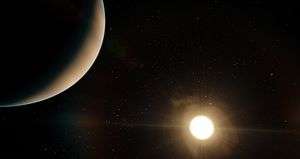HD 240237 b
| Exoplanet | List of exoplanets | |
|---|---|---|
 | ||
| Parent star | ||
| Star | HD 240237 (BD+57° 2714) | |
| Constellation | Cassiopeia | |
| Right ascension | (α) | 23h 15m 42.22361s |
| Declination | (δ) | +58° 02′ 35.6654″ |
| Apparent magnitude | (mV) | 8.19 |
| Distance | 4,900 ly (1,500[1] pc) | |
| Spectral type | K2III[2] | |
| Mass | (m) | 1.69 (± 0.42)[2] M☉ |
| Radius | (r) | 32 (± 1)[2] R☉ |
| Temperature | (T) | 4361 (± 10)[2] K |
| Metallicity | [Fe/H] | −0.26 (± 0.07)[2] |
| Age | ~2 Gyr | |
| Physical characteristics | ||
| Mass | (m) | 5.3[2] MJ |
| Radius | (r) | ~1.11 RJ |
| Stellar flux | (F⊙) | 100.4[3] ⊕ |
| Temperature | (T) | 781 K (508 °C; 946 °F) |
| Orbital elements | ||
| Semi-major axis | (a) | 1.9 AU |
| Eccentricity | (e) | 0.4 (± 0.1) |
| Orbital period | (P) | 745.7 (± 13.8) d |
| Argument of periastron |
(ω) | 108.1 ± 21.8° |
| Time of periastron | (T0) | 54,292 ± 28.3 JD |
| Semi-amplitude | (K) | 91.5 ± 12.8 m/s |
| Discovery information | ||
| Discovery date | 9 October 2011 | |
| Discoverer(s) | ||
| Discovery method | Doppler spectroscopy | |
| Discovery status | Confirmed | |
| Database references | ||
| Extrasolar Planets Encyclopaedia | data | |
| SIMBAD | data | |
| Exoplanet Archive | data | |
| Open Exoplanet Catalogue | data | |
HD 240237 b is a super-Jupiter exoplanet orbiting the K-type giant star HD 240237 about 4,900 light-years (1,500 parsecs, or nearly 4.6×1016 km) away from Earth in the constellation Cassiopeia. It orbits outside of the habitable zone of its star at a distance of 1.9 AU. The exoplanet was found by using the radial velocity method, from radial-velocity measurements via observation of Doppler shifts in the spectrum of the planet's parent star. The planet has a mildly eccentric orbit.
Characteristics
Mass, radius and temperature
HD 240237 b is a "super-Jupiter", an exoplanet that has a radius and mass larger than that of the gas giants Jupiter and Saturn. It has a temperature of 781 K (508 °C; 946 °F), around that of the surface temperature of Venus.[3] It has an estimated mass of around 5.3 MJ and a potential radius of around 9% larger than Jupiter (1.11 RJ, or 12.2 R⊕) based on its mass, since it is more massive than the jovian planet.
Host star
The planet orbits a (K-type) giant star named HD 240237. It has exhausted the hydrogen supply in its core and is currently fusing helium. The star has a mass of 1.69 M☉ and a radius of around 32 R☉. It has a surface temperature of 4361K and is likely 2 billion years old based on its mass and evolution. In comparison, the Sun is about 4.6 billion years old[4] and has a surface temperature of 5778 K.[5]
The star's apparent magnitude, or how bright it appears from Earth's perspective, is 8.19. Therefore, HD 240237 is too dim to be seen with the naked eye.
Orbit
HD 240237 b orbits its star with nearly 331 times the Sun's luminosity (331 L☉) every 746 days at a distance of 1.9 AU (compared to Mars' orbital distance from the Sun, which is 1.52 AU). It has a mildly eccentric orbit, with an eccentricity of 0.4.
Discovery
The planet was detected through Doppler spectroscopy, the method of observing exoplanets through the measurement of radial velocities of a star. If there is a wobble, it could mean that there is a possible planetary companion orbiting it.
Observations were taken with the Hobby-Eberly Telescope equipped with the High-Resolution Spectrograph in a queue-scheduled mode.[2] From July 2004 to October 2009, 40 epochs were measured, with SNR values ranging from 161–450. These observations eventually led the team to conclude that there was in fact a planetary companion orbiting around HD 240237, and they estimated its parameters to be a mass of 5.3 times that of Jupiter, an orbital period of 746 days, an eccentricity of 0.4, and a semi-major axis of 1.9 AU. The discovery, along with 2 other exoplanets, were announced on October 9, 2011.[2]
See also
References
- ↑ "Notes for planet HD 240237 b". The Extrasolar Planets Encyclopaedia. Retrieved 2016-07-29.
- 1 2 3 4 5 6 7 8 Gettel, S.; Wolszczan, A.; Niedzielski, A.; Nowak, G.; Adamów, M.; Zieliński, P.; Maciejewski, G. (2011). "Substellar-Mass Companions to the K-Giants HD 240237, BD +48 738 and HD 96127". The Astrophysical Journal. 745: 28. arXiv:1110.1641. Bibcode:2012ApJ...745...28G. doi:10.1088/0004-637X/745/1/28.
- 1 2 http://www.hpcf.upr.edu/~abel/phl/hec_plots/hec_orbit/hec_orbit_HD_240237_b.png
- ↑ Fraser Cain (16 September 2008). "How Old is the Sun?". Universe Today. Retrieved 2011-02-19.
- ↑ Fraser Cain (September 15, 2008). "Temperature of the Sun". Universe Today. Retrieved 2011-02-19.
External links
- "Notes for planet HD 240237 b". The Extrasolar Planets Encyclopaedia. Retrieved 2016-07-29.